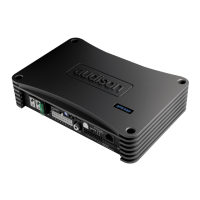In order to configure the inputs, amplified and pre-amplified power outputs, EQ and time delays for AP8.9 bit, it must
be interfaced with the PC. When you get to this point you must already be aware of what type of system you intend to
set up. In order to change these choices at a later date, you will need to perform the guided procedure again.
The guided procedure will ask:
- The type of specialization for the main input channels used. The guided procedure changes according
to your choice.
- The type of signals that will be assigned to the main inputs (e.g.: Front Left or Center or Subwoofer, etc.).
- The speakers in the system (e.g.: 3 way Front or Sub Stereo or 2 way Rear, etc.).
- If there are passive crossovers that manage groups of speakers (e.g.: 3 way systems with active midrange).
- If you intend to use an external monophonic amplifier to drive a Subwoofer or an external amplified subwoofer.
- If you intend to use the amplified outputs on AP8.9 bit in BRIDGE configuration, thus increasing the power
on the output.
WARNING: During this operation, we recommend disconnecting the power connector from AP8.9 bit to
the speakers, disconnecting the SPEAKER OUT connection.
(see sec. 4.4)
1. Connect the speaker outputs or the Pre Out outputs from the INPUTS on AP8.9 bit (see sec. 4.2). Before
turning on the
system, make sure the power outputs are disconnected from AP8.9 bit to avoid damaging the speakers during
calibration.
The input calibration operation must be performed with the vehicle engine running. In this case, the voltage is
about 14.0 V. The source will provide an undistorted output signal at higher volume.
2. Turn on AP8.9 bit and connect the USB cable to the PC. Start AP8.9 bit software by clicking on the icon on the
PC Desktop that was created upon installation.
3. If synchronization is successful, a communication window will appear that shows the data exchange between the
processor and software. Wait a few seconds.
7.2 TARGET MODE
7

